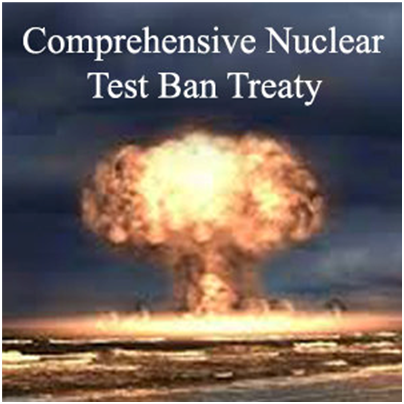What is the full form of CTBTCTBT: Comprehensive Nuclear Test Ban TreatyCTBT stands for Comprehensive Nuclear Test Ban Treaty. It is a multilateral treaty that bans all nuclear test explosions and other nuclear explosions for civilian or military purposes. The treaty was adopted by the United Nations General Assembly, and it was opened for signature on 24 September 1996. The treaty is signed by 182 countries. As of 2016, Trinidad and Tobago are the last nations to sign the treaty. 
Importance of CTBTIt acts as a barrier to the development of nuclear weapons. It does not allow the development of new nuclear weapons or any improvement in the existing nuclear weapons. It is a legally binding norm against nuclear testing. It prevents human suffering and damage to the environment due to nuclear explosions. History of Nuclear TestsOver 2000 nuclear tests were conducted by different countries between 1945 and 1996 before the CTBT was adopted:
After 1996, three countries conducted nuclear tests: India and Pakistan in 1998 and North Korea in 2006 and 2009. The treaty has not entered into force yet as there are 44 countries that didn't sign and ratify the treaty. As of August 2011, 35 of these 44 countries have ratified the treaty. The nine countries that did not ratify it are India, Iran, Israel, Pakistan, China, Egypt, Indonesia, the United States, and North Korea. Out of these nine countries, India, Pakistan, and North Korea have not yet signed it. Difference between signing and ratifying the CTBTIf a country Signs the treaty, it means the country accepts the treaty and will not take any action against the purposes of the treaty. It is signed by the senior representative of a country, such as the president, prime minister, foreign minister, etc. If a country ratifies the treaty, it means it is officially sanctioned to make it legally binding for the government of the country. In this process, the treaty is adopted by the Legislature of the country, such as the Parliament. Then the instrument of ratification is submitted to the UN Secretary-General. Comprehensive Test Ban Treaty's goalsA comprehensive monitoring and verification system, including an international monitoring system and international data centre, as well as national technical means and tens of thousands of civilian monitoring stations, will be established by the CTBTO (the organisation that oversees the CTBT and the Secretariat of the Conferences), increasing confidence among all nations that nuclear testing will not take place. The Comprehensive Test Ban Treaty's goals are listed below:
CTBT's entry into force
Next TopicFull Form
|
 For Videos Join Our Youtube Channel: Join Now
For Videos Join Our Youtube Channel: Join Now
Feedback
- Send your Feedback to [email protected]
Help Others, Please Share










